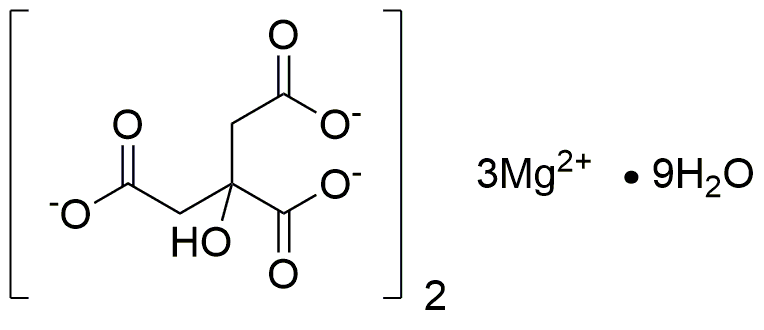Magnesium citrate tribasic nonahydrate is widely utilized in research focused on:
- Dietary Supplements: This compound serves as a source of magnesium, which is essential for various bodily functions. It is commonly found in dietary supplements aimed at improving overall health and wellness.
- Pharmaceuticals: In the pharmaceutical industry, it is used as a laxative and to manage magnesium deficiency, providing a safe and effective option for patients.
- Food Industry: It acts as a food additive, enhancing the nutritional profile of products while also serving as a stabilizer and emulsifier in various food formulations.
- Cosmetics: The compound is incorporated into skincare products for its moisturizing properties, helping to improve skin hydration and overall texture.
- Research Applications: In scientific studies, it is used in biochemical assays and experiments to explore magnesium's role in cellular processes, contributing valuable insights to nutritional and health research.
General Information
Properties
Safety and Regulations
Applications
Magnesium citrate tribasic nonahydrate is widely utilized in research focused on:
- Dietary Supplements: This compound serves as a source of magnesium, which is essential for various bodily functions. It is commonly found in dietary supplements aimed at improving overall health and wellness.
- Pharmaceuticals: In the pharmaceutical industry, it is used as a laxative and to manage magnesium deficiency, providing a safe and effective option for patients.
- Food Industry: It acts as a food additive, enhancing the nutritional profile of products while also serving as a stabilizer and emulsifier in various food formulations.
- Cosmetics: The compound is incorporated into skincare products for its moisturizing properties, helping to improve skin hydration and overall texture.
- Research Applications: In scientific studies, it is used in biochemical assays and experiments to explore magnesium's role in cellular processes, contributing valuable insights to nutritional and health research.
Documents
Safety Data Sheets (SDS)
The SDS provides comprehensive safety information on handling, storage, and disposal of the product.
Product Specification (PS)
The PS provides a comprehensive breakdown of the product’s properties, including chemical composition, physical state, purity, and storage requirements. It also details acceptable quality ranges and the product's intended applications.
Certificates of Analysis (COA)
Search for Certificates of Analysis (COA) by entering the products Lot Number. Lot and Batch Numbers can be found on a product’s label following the words ‘Lot’ or ‘Batch’.
*Catalog Number
*Lot Number
Certificates Of Origin (COO)
This COO confirms the country where the product was manufactured, and also details the materials and components used in it and whether it is derived from natural, synthetic, or other specific sources. This certificate may be required for customs, trade, and regulatory compliance.
*Catalog Number
*Lot Number
Safety Data Sheets (SDS)
The SDS provides comprehensive safety information on handling, storage, and disposal of the product.
DownloadProduct Specification (PS)
The PS provides a comprehensive breakdown of the product’s properties, including chemical composition, physical state, purity, and storage requirements. It also details acceptable quality ranges and the product's intended applications.
DownloadCertificates of Analysis (COA)
Search for Certificates of Analysis (COA) by entering the products Lot Number. Lot and Batch Numbers can be found on a product’s label following the words ‘Lot’ or ‘Batch’.
*Catalog Number
*Lot Number
Certificates Of Origin (COO)
This COO confirms the country where the product was manufactured, and also details the materials and components used in it and whether it is derived from natural, synthetic, or other specific sources. This certificate may be required for customs, trade, and regulatory compliance.

